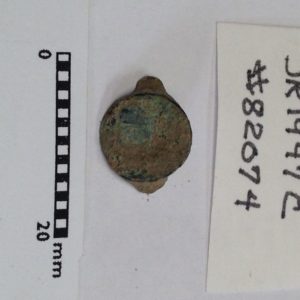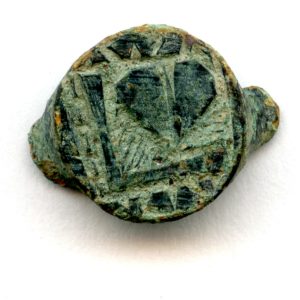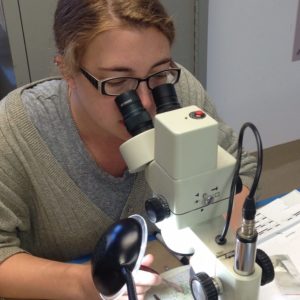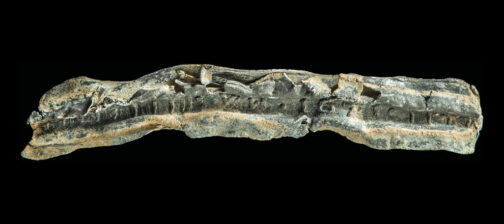Working in the archaeological lab this winter, assistant conservator Katy Corneli has spent some of her time conserving small copper-alloy artifacts. Much of the work is done while peering through a microscope and working with fine tools such as scalpels and paintbrushes. Some of the small copper-alloy artifacts she has conserved include finger rings, buttons for doublet vests, and coin weights, which were used with scales to determine the quality of coinage.
One of the more curious items that Katy conserved was a piece of a small Jesuit ring called an L-heart ring. These rings were originally given to Jesuit students for completing their lessons, but over time they became more popular and were used as trade items with Native Americans. Both a capital “L” and a heart shape are clearly visible on the ring. While the heart likely represents the Sacred Heart of Jesus, the meaning of the L is not fully understood. The L shape could represent either King Louis XIII or XIV of France, but it could also relate to the Latin word “laudare,” meaning to praise.
This item was found in the plowed layers of soil around James Fort, which means it came out of a mixed context of soil that cannot be tightly dated. It is peculiar that the ring was found on Jamestown Island because these rings are typically found on French sites in Canada and upstate New York, where French Jesuit activity with the Native Americans was commonplace. The presence of this item at Jamestown will likely remain a mystery, but there is one intriguing possibility: In 1613 English Captain Samuel Argall, operating out of Jamestown, raided a French colony in present day Maine and may have brought back to Jamestown 15 prisoners, including two priests. Perhaps this ring was a product of this 1613 raid.
Katy conserved the ring by first physically removing some of the corrosion with a scalpel, a wooden tool, and a paintbrush while working underneath the microscope. The last layer of corrosion before the true metal is left in place as a protective layer. After this process is complete, the object is soaked in acetone and denatured alcohol to remove any foreign elements on the surface. Then the ring is dipped in a compound called BTA, which adheres with the copper to give it a protective coating against moisture and oxygen, the main causes of corrosion. Finally, the object is coated with a paint brush in a reversible acrylic that hardens onto the object to also keep moisture and oxygen from breaking down the ring.
related images
- The ring under the microscope
- The Jesuit heart ring prior to conservation
- The heart ring during conservation
- Conservator Katy Corneli conserving copper alloy objects under the microscope










